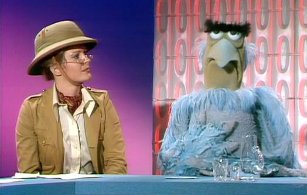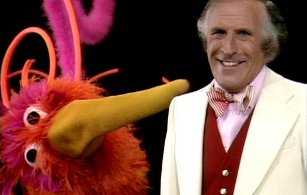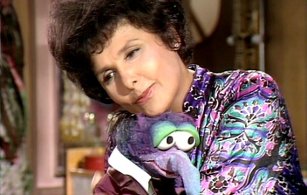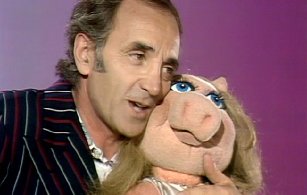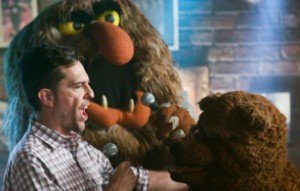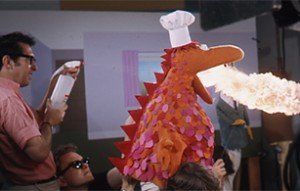The Muppet Show 1.15: ‘Candice Bergen’...
With Candice Bergen, The Muppet Show had a perfect opportunity to concoct a classic episode. After all, it was rare for them to find a guest so comfortable with puppets. In fact, she had likely spent most of her younger years surrounded by them, given that her father was the great Edgar Bergen, one of America’s foremost puppeteers...
The Muppet Show 1.14: “Sandy Duncan”...
After at least a handful of uneven episodes–sometimes due to not utilizing a great guest star to their best advantage and other times due to a middling performance by a guest star dragging the proceedings down a bit–The Muppet Show finally finds its footing again with the Sandy Duncan episode, which benefits from a delightful...
The Muppet Show 1.13: “Bruce Forsyth”...
With the Bruce Forsyth episode, we have yet another mostly lackluster celebrity appearance. This isn’t helped by the fact that, despite Kermit extolling his virtues and calling him a “one-man variety show,” his singing, dancing, and comedic stylings fail to impress–or at least fail to impress a modern eye. I...
The Muppet Show 1.12: “Peter Ustinov”...
The Peter Ustinov episode of The Muppet Show is a perfect example of how, no matter how iconic and storied the guest star, whenever the Muppets failed to incorporate them into any musical numbers, the show usually suffered, particularly in the first season, when the writers made up for non-singing guests’ lack of singing by featuring...
The Muppet Show 1.11: “Lena Horne”...
Growing up, my only real point of reference for Lena Horne was that she was a celebrity who appeared on Sesame Street, but in her relatively brief scenes, she exuded a warm, gentle glow that, even at a young age, made me sense that she was one of those people who really got the Muppets. She and they seemed to fit together so naturally that I...
The Muppet Show 1.09: ‘Charles Aznavour̵...
In previous posts, I spoke of how, in the first season, before The Muppet Show became a massive hit and celebrity guest stars were banging down the doors to appear, the show paid host to a number of lower-tier stars who were friends of the producers, doing them favors. Well, given that the singer, Charles Aznavour, who Kermit calls an...
The Muppet Show 1.08: “Paul Williams”...
Remarkably, the Paul Williams episode of The Muppet Show received an Emmy nomination for Best Writing on a Variety Show. Unfortunately, the reason I find it remarkable is that it is easily the most poorly written episode up to this point with a higher-than-usual number of jokes that completely fail to land–for example, the Newsman...
Tale of Sand
In the late 60s, Jim Henson and Jerry Juhl collaborated on a screenplay called Tale of Sand, a darkly humorous, extremely ambitious work reminiscent of Time Piece in its imagery-heavy, stream-of-consciousness, deliberately nonsensical (in the Lewis Carroll sense of the word) flow and its surrealist depiction of what is essentially an existential crisis on screen, however much larger in scope to the former film, not only because it was intended to be feature-length but due to the sheer complexity of the visuals.
Like Time Piece, it’s more of a plunge into a bizarre fever dream than a narrative, and it’s probable that its weirdness and therefore probable lack of accessibility accompanied with how expensive it would be to produce led to its never having been made.
Read MoreMuppets for IBM
In 1965, IBM hired Jim Henson to make a number of short “industrial” films for their company, which were effectively intended as comedic shorts to break the tedium of long meetings. Later on, Jim would produce similar short pieces called the Muppet Meeting Films which could be used for any corporate client, and some of which were actually remakes of these early bits for IBM. I wasn’t able to get exact dates for all of these films, and some of them I know are from 1965, so I’ll be jumping backwards in the chronology a bit here, but it seemed like it would make most sense in this case to combine them all in one place.
What is likely the earliest of the set is a 4-part film starring Rowlf in which he writes home to his mom, documenting his first year as a salesdog for
Read MoreRipples, Wheels, Etc.
In 1967, Jim Henson made a one-minute short film for “Expo67,” which was a World’s Fair, in Montreal, Quebec. Called Ripples, it is reminiscent of Time Piece in its use of a stream-of-consciousness series of images that flow emotionally rather than logically, however in a much more compressed format, as well as the Bufferin ad in the previous post in its exploration of the human mind. Over the course of the minute, an architect played by Jon Stone–a producer who collaborated with Jim on a Cinderella pilot in 1965, and would later bring Jim on board to Sesame Street, and even later write The Monster at the End of This Book–drops a lump of sugar into his coffee, causing ripples in the glass, which fades to a shot of him by a lake, tossing pebbles into the water, each ripple bringing up images in his mind of architecture and art, moments of great progress throughout history and the then-modern day/future (illustrated via shots of NASA rockets and mission control centers), his home life, and his family. In a few short moments, it establishes ripples of connection between humanity, human progress and achievement, nature, and us.
Read More
Shrinkenstein and Beyond
Today, we return to more of Jim and Muppets, Inc.’s commercial work. All of them, as far as I can tell, are from 1967. The first is yet another Pak-Nit storytime, like the earlier Shrinkel and Stretchel and Rumple Wrinkle Shrinkel Stretchel Stiltzkin, however this time, rather than a fairy tale, Jim adapts and skews Mary Shelley’s classic horror tale, Frankenstein, into a fractured Pak-Nit fable called Shrinkenstein about a mad scientist–played by the apparently ever-popular Prime Minister muppet from Tales of the Tinkerdee–who creates an evil creature–played by the Muppet monster, Big V (who first devoured Kermit in the “Glow Worm” sketch)–who rampages across the countryside, causing clothes to shrink in the wash! And he would have gotten away with it, too, if it weren’t for that meddling scientist, who “goes sane” just in time to create Pak-Nit, who defeats
Read MoreThe Hollywood Palace, Etc.
Today, I have a whole bunch of Muppet variety show appearances from 1966-1967 to make up for my lack of this sort of footage for the previous decade, each of them fantastic in their own right, most of them musical, and two of them ending with Kermit being devoured by a monster (well, technically three, but as it turns out, one of these sketches was a recycling of a previous one), one of Jim’s signature sketch-ending touches.
We start out at The Hollywood Palace, a weekly show that was broadcast from the ABC Palace Theatre in Hollywood on Saturday nights. The Muppets appeared on the show twice, and I was lucky enough to be able to get both clips. The first was filmed on March 19,
Read MoreThe Muppets 1.04: “Pig Out”
After a mostly fun but slightly shaky third episode, The Muppets rebounds…mostly in its fourth outing, “Pig Out”. If there’s one thing this show has been absolutely fantastic at, it’s been finding new ways to explore these classic characters, paying respect to their past incarnations while either planting little seeds that yield fresh revelations and perspectives or simply reasserting what we’ve always known and loved about them in entirely fresh ways.
A great example of the former in this one is the sweet little reveal that Sam the Eagle has a huge crush on Janice. Sam has never been the most–for lack of a better word–human Muppet. The reason that he’s so perfectly cast as a network standards and
Read MoreLa Choy and More!
As 1966 rolled around, Jim and Muppets, Inc., were handling more new ad clients than ever before, particularly with Rowlf’s immense celebrity helping to push them into household name status. And I watched a whole slew of them for today’s post, beginning with the commercials he filmed for the Wilson’s Meats company, featuring Skip and Scoop, two more Muppets who largely seem to be in the Wilkins/Wontkins mold of one character being more excited by the product than the other, however at least from the ads I got a chance to see, are actually a bit closer to the Bert and Ernie dynamic in that there seems to be less physical violence between them
Read More
